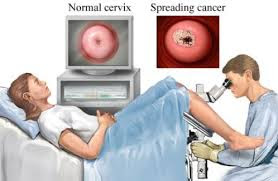Cervical Cancer Early Detection
 |
| Illustration of Cervical cancer Earlier Detection |
Cervical Cancer Early Detection. Early detection of cervical cancer done routinely undergo regular Pap smear tests. Here is a GUIDE early detection (screening) of cervical cancer do :
- Cervical cancer screening should begin at age 21 years. Screening before age 21 should be avoided because it may increase the risk.
- Pap Smear Test is recommended every 2 years for women aged 21-29 years.
- Women aged 30 years and older who have three times (3x) consecutive test results of her Pap smear negative and with no history of CIN 2 or CIN 3, are not HIV-infected, do not have a problem with the immune system, and are not affected diethylstilbestrol in utero, can extend the interval between Pap tests to every 3 years.
- Method of conventional Pap smear or liquid-based cytology, can be used in women who have undergone a total hysterectomy (surgical removal of the uterus), for benign uterine tumors and did not have a history of high-grade CIN, routine Pap tests should be stopped.
- The combination of Pap smear test to HPV DNA test is the appropriate screening for women aged older than 30 years. Each low-risk women, aged 30 years or more, and who receive a negative test result on the above second screening, should be screened again, but no sooner than 3 years later.
- Because cervical cancer develops slowly and risk factors decrease with age, it is reasonable to discontinue cervical cancer screening in women aged between 65-70 years, who have three or more negative Pap test results in a row and no Pap test results abnormal smear in the last 10 years.
- Women who in the past have 2/CIN treatment for CIN 3, or cervical cancer remain at risk of cervical cancer for at least 20 years after treatment and after a period of initial observation, and should continue to have annual screening for at least the next 20 years.
- Women who have received immunization for the virus HPV-16 and HPV-18, still have a cervical cancer screening test as above.

0 comments:
Post a Comment